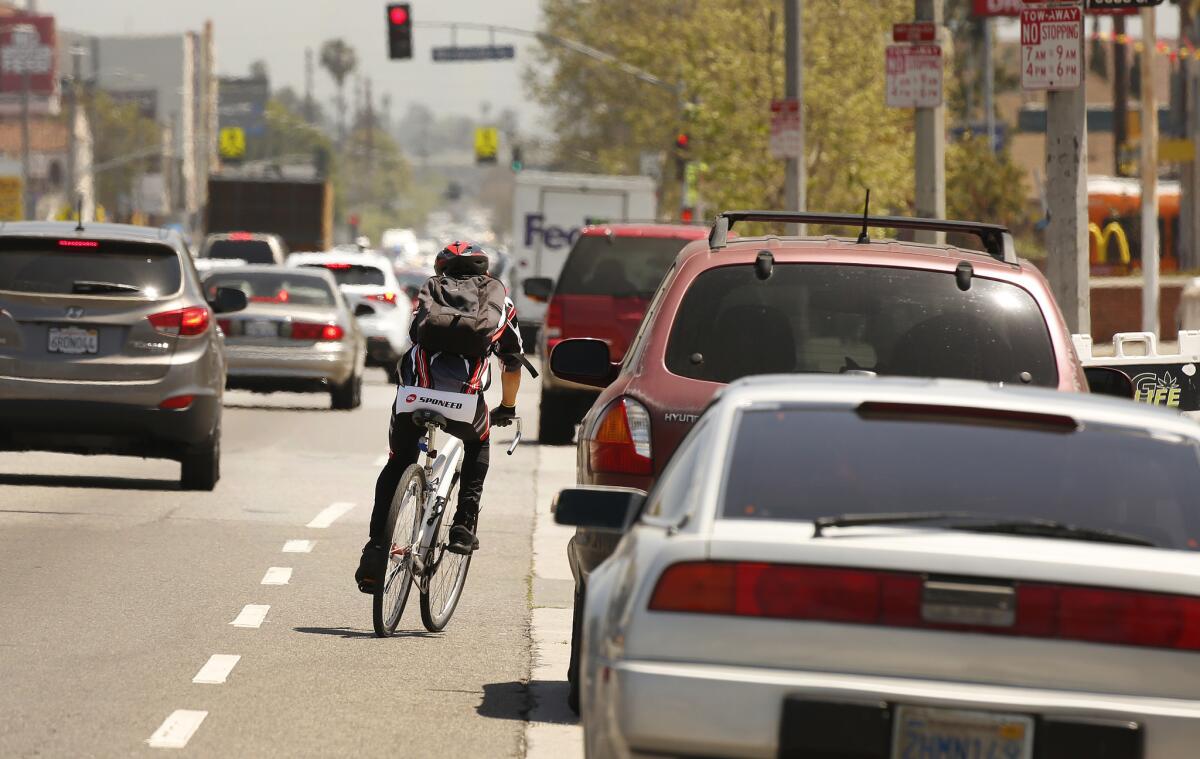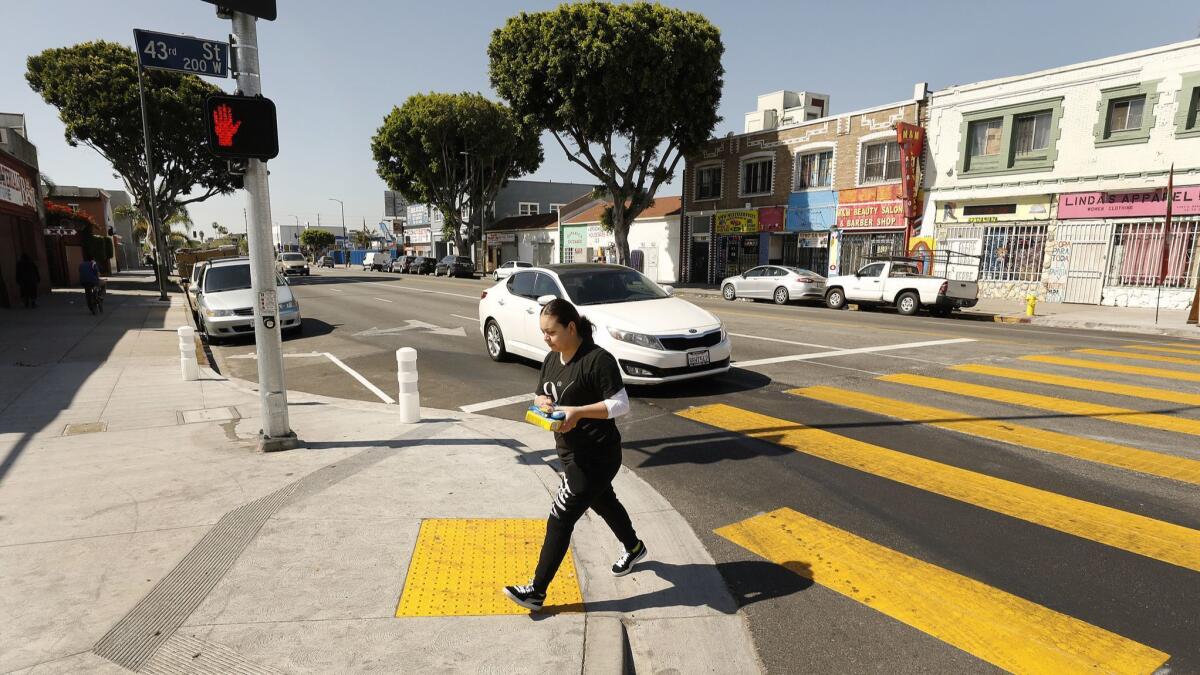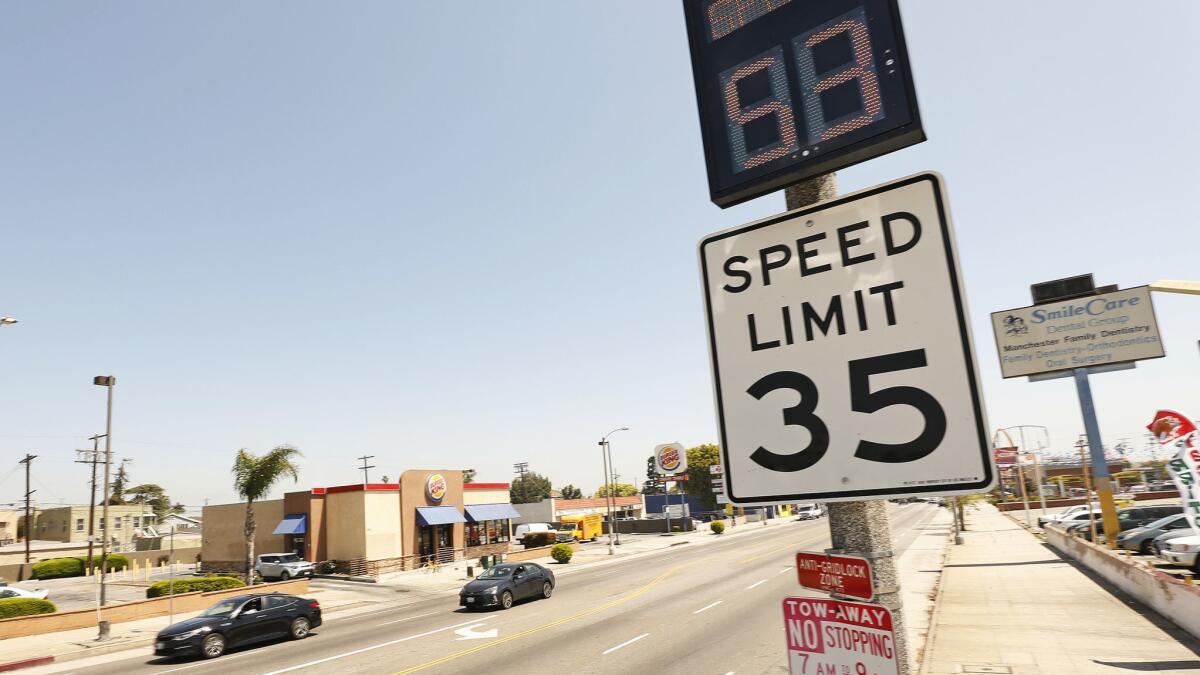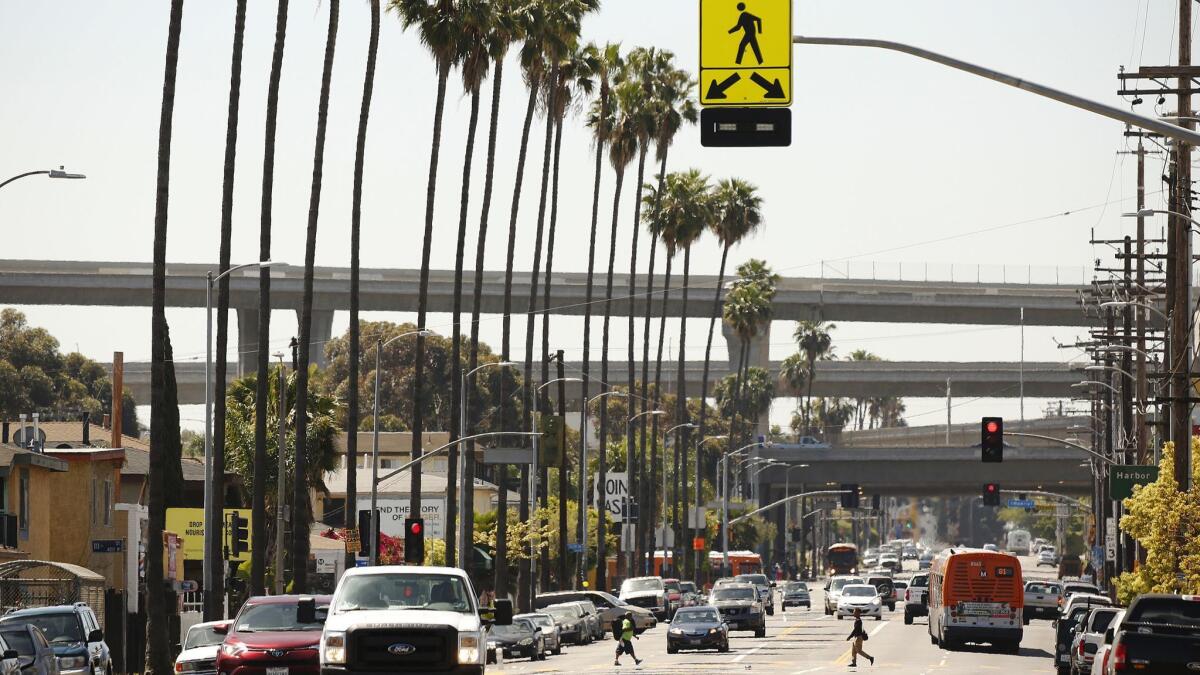More people are dying on L.A.’s streets despite a push to eliminate traffic fatalities

On a clear afternoon last April, Frederick Frazier was riding his bike in South Los Angeles, headed to help a friend fix a flat tire, when a driver in a Porsche Cayenne rear-ended him.
Frazier, who had been in the curb lane of Manchester Avenue, was thrown more than 50 feet through the air. The speeding SUV hit the 22-year-old with such force that it shattered his white-and-blue bicycle. He died in the street as the driver sped away.
Afterward, city crews installed more visible crosswalks, yield signs and digital signs that tell drivers their speeds on Manchester, one of the deadliest streets in Los Angeles for bicyclists and pedestrians. Activists say the changes are a good start, but don’t do enough.
“You hear these terrible stories because drivers aren’t cautious,” said Edin Barrientos, 27, a bike messenger and a friend of Frazier’s who has been fighting for a bike lane on Manchester. “No one’s life is worth you driving that fast or that recklessly.”
The upgrades to Manchester are among hundreds made during the first 3½ years of Vision Zero, an initiative by Mayor Eric Garcetti to eliminate traffic deaths on Los Angeles streets by 2025.
But rather than decline, fatal car crashes have risen 32% since 2015, the year Vision Zero began. In that time, more people have died in traffic collisions — 932 — than were shot to death in the city, according to coroner’s data.
Vision Zero has worked in Europe, where it began in Sweden two decades ago, and in New York City, where fatalities have fallen to the lowest recorded level in a century. But progress has been uneven on L.A.’s sprawling, 7,500-mile street grid, where speeding and distracted driving are common, and traffic fatalities rarely spark public outcry.
There has been a modest decline in the number of deaths over the last two years, which city officials attribute to new street safety projects. In 2017, 246 people died. Last year, the number was 242, including 127 people walking and 21 people on bicycles, a decline of 1.63%.
“It was an improvement,” Garcetti said last month. “… Do I want that to go faster and quicker? Always.”
But Vision Zero has not reduced fatalities enough to meet its early benchmarks, including the 20% reduction in deaths that the city should have achieved in 2017. Without a greater sense of urgency among drivers and elected officials, advocates say, Los Angeles will not come close to eliminating traffic deaths by 2025.
“We are failing on Vision Zero,” said Michael MacDonald, an architect who has lobbied for more protected bicycle lanes. “That doesn’t mean Vision Zero is a failure. We’re failing because we’re not acting.”
The guiding philosophy of Vision Zero is that no death or serious injury in a traffic collision is acceptable. Human error is inevitable, the ethos goes, but the design and engineering of a street should ensure that crashes are minor.
How to measure progress when deadly crashes do occur is a matter of some dispute, though.
New York City began Vision Zero in January 2014. The city measures its progress from 2013, the year before the initiative began. After three years of work, deaths had fallen 23%, and continue to fall, reaching a 33% decline after five years.
Vision Zero in Los Angeles began in August 2015. The city measures progress from 2016 because it was the first full year the initiative was in effect, Transportation Department spokesman Oliver Hou said. By that calculation, deaths have fallen 7%.
But 2016 was also the deadliest year in recorded history for traffic crashes, and by December of that year, Vision Zero had been in place for 18 months. Some advocates have questioned whether it should count as the baseline year.
“In 2016, deaths went up a lot and they moved the goalposts,” MacDonald said. “You need to see significant declines every year to meet the goal. That’s not going to happen if you’re relying on fluctuations and statistical aberration to show you’re making progress.”
Fatalities have risen 26.7% from 2014, the year before Vision Zero began, or 32% since 2015.
Officials in Los Angeles have spent three years analyzing fatality data, working to make speed limits enforceable and rolling out hundreds of upgrades to 40 streets where a disproportionate share of the city’s traffic deaths and severe injuries occur.

The Transportation Department made about 1,080 changes to streets in 2017 and 289 last year, Hou said. The city changed the timing on traffic signals, added fresh paint to hundreds of crosswalks and installed white plastic posts at dozens of street corners to force drivers to slow down.
Of the 40 most dangerous streets, 26 — including Manchester — have new safety features. An additional seven are slated to be finished by June. Six larger reconstruction projects will take longer because they call for street resurfacing and the installation of traffic signals, sidewalks and protected bike lanes, according to the city.
“We are headed in the right direction,” said Daniel Samaro, a senior engineer with the city’s Vision Zero program. “We are working in the right places. We will get back on track.”
Additional funding from Senate Bill 1, the legislation that raised California’s gas tax and vehicle fees, will pay for more makeovers of major corridors, Garcetti said.
His proposed budget, released last week, includes $117 million for traffic and safety improvements, up from $91 million last year. That includes $28.5 million from the city’s general fund, $45.9 million from SB 1 and $42.6 million from Measure M, the 2016 sales tax increase for transportation projects, Garcetti spokesman Alex Comisar said.
The Transportation Department also has created a rapid-response team that can make quick changes to a dangerous street or intersection after a fatal collision.
Every upgrade helps, advocates say. But until Los Angeles can create a sense of urgency among drivers and an awareness that speeding can have deadly repercussions, the number of deaths won’t fall meaningfully.
“We’re doing little Band Aid improvements,” said Deborah Murphy, founder of Los Angeles Walks, a pedestrian advocacy organization. “Until we change the physical construction of our streets, people are not going to perceive them differently. They are going to continue to speed.”
California law complicates matters by creating a Catch-22 that can force cities to raise the speed limit in order to enforce it. It stipulates that if the speed limit on a major street is out of date or doesn’t reflect the natural flow of traffic, police can’t use electronic devices to catch speeders there.
During the first two years of Vision Zero, city officials updated hundreds of miles of expired speed studies so the Los Angeles Police Department could resume writing speeding tickets. That has led to increases in speed limits on nearly 200 miles of streets.

Allowing motorists to drive faster in exchange for more speeding enforcement can be a bitter pill, officials say, because speed is often a determining factor in whether someone survives a crash. A pedestrian has a 10% risk of death when struck by a vehicle moving at 20 mph, but an 80% risk of death at 40 mph.
The best way to slow down drivers is to remove a travel lane, Murphy said. Such projects, called “road diets” because they reduce space for drivers, can reduce severe injuries and deaths by up to 47%, according to federal data.
But the projects can be controversial in Los Angeles, where commuters want to preserve their easy driving routes.
In 2017, nine miles of road diets installed in Mar Vista and Playa del Rey sparked lawsuits, months of complaints and an unsuccessful attempt to recall Councilman Mike Bonin. Within months, many of the changes were reversed.
The fallout left transportation officials leery of reliving the experience.
The Transportation Department now has a checklist that must be satisfied before taking away travel lanes to install bike lanes, including studying the effect on traffic and business owners.
Garcetti said he supported road diets as a councilman and as mayor, and sees the projects as “critical” to street safety. He said he would support projects in communities that “want to do that.”
Barrientos and other activists have been working to build support for a bike lane on Manchester, talking to business owners, community groups and churches.
Residents know the street is deadly, he said, but worry that a bike lane could spark gentrification in one of the last affordable areas of Los Angeles.
The city’s master document for bike and bus lanes calls for a protected bicycle lane along 3.6 miles of Manchester, between L.A.’s border with Inglewood and Central Avenue in Florence.
A study of possible lane reconfiguration options is scheduled to be finished this summer, Transportation Department spokeswoman Patricia Restrepo said.
Meanwhile, another cyclist was killed two months ago in a hit-and-run collision on Manchester, less than a mile from where Frazier died. Joseph Prandoni, 32, was an artist who delivered food on his bicycle to pay the bills.
“Something has to be done,” Barrientos said. “Every day, people get hit. People are dying. And no one is doing anything about it.”

Times staff writer Dakota Smith contributed to this report.
For more transportation news, follow @laura_nelson on Twitter.
More to Read
Sign up for Essential California
The most important California stories and recommendations in your inbox every morning.
You may occasionally receive promotional content from the Los Angeles Times.











